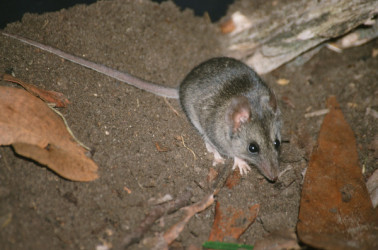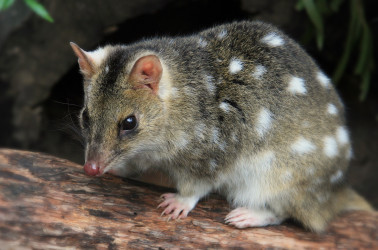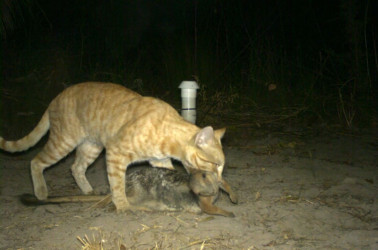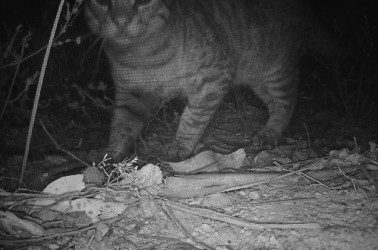Kangaroo Island Dunnart:
The Kangaroo Island Dunnart is a small dark-sooty-grey-coloured dunnart species that is found only on South Australia’s Kangaroo Island. A nocturnal species, their diet consists of mainly of ants and spiders and occasionally scorpions, beetles and grasshoppers. The current population size is hard to determine due to their elusiveness, with an approximate population of 300 individuals. Currently the dunnart is known from only 12 remote locations within the western end of the island.
The Kangaroo Island Dunnart is on the brink of extinction with feral cats being identified as the key contributor to their decline. In response, we aim to reduce the feral cat numbers within Kangaroo Island Dunnart habitat by at least 80% by 2021. This action ensures the survival of the Kangaroo Island Dunnart and without it they will likely become extinct.
Western Quoll:
The Western Quoll, known also as Idnya or Chuditch, is a small brown spotted carnivorous marsupial. While remnant populations can be found in Western Australia, we, along with the South Australian Department of Environment and Water (DEW), in a groundbreaking program helped reintroduce them to South Australia’s Ikara-Flinders Ranges in 2014 after 100 years of local extinction.
The population has expanded from the original 37 individuals released and is now thriving for one reason – extensive on-ground control of feral cats and foxes. This action is essential for the recovery of the Western Quoll in South Australia. We’ve made a commitment to reduce the feral cats in the Ikara-Flinders Ranges and maintain control activities in 2020 and 2021.
Controlling Feral Cats:
The control of feral cats is being undertaken through the use of Felixer grooming traps, Eradicat baits and the involvement of the Sporting Shooters Association of Australia (South Australia branch).
To some this may seem inhumane, yet to do nothing could lead to the extinction of the Kangaroo Island Dunnart and the Western Quoll in South Australia as well as other susceptible mammals, reptiles and birds.
On Kangaroo Island, feral cats are controlled by the use of detector dogs, cage trapping, spotlight shooting and Felixer grooming traps.
By supporting FAME with a donation to this special appeal, I can assure you that the Kangaroo Island Dunnart will have the best chance of survival. We aim to protect the KI Dunnart from further decline through establishing a feral free fenced refuge on Western Kangaroo Island, know as the Western River Refuge.
With our support the South Australian Department of Environment and Water has been undertaking feral-cat control measures in the Ikara-Flinders Ranges for five years and the success of the Western Quoll project clearly shows this is importnat for the successful reintroduction of extinct mammals to their former habitats. However, due to the large numbers of feral cats in surrounding areas, any interruptions to control programs would see predation increase. Feral cat numbers are so overwhelming, the problem is so large, that Western Quolls and other wildlife in the Ikara-Flinders Ranges need ongoing help.
Our surveys have shown that Western Quolls are breeding successfully. Numbers can grow rapidly once predators are controlled.
Our projects to save the Kangaroo Island Dunnart and the Western Quoll in South Australia have required extensive planning and involve additional actions that include surveying, monitoring, some fencing and translocating individuals to create new populations.
Direct attacks from feral cats are killing Kangaroo Island Dunnarts and Western Quolls right now. We must stop feral cats in their tracks.
Photos credits: Jody Gates (Kangaroo Island Dunnart) and Michael J Barritt (Western Quoll)



